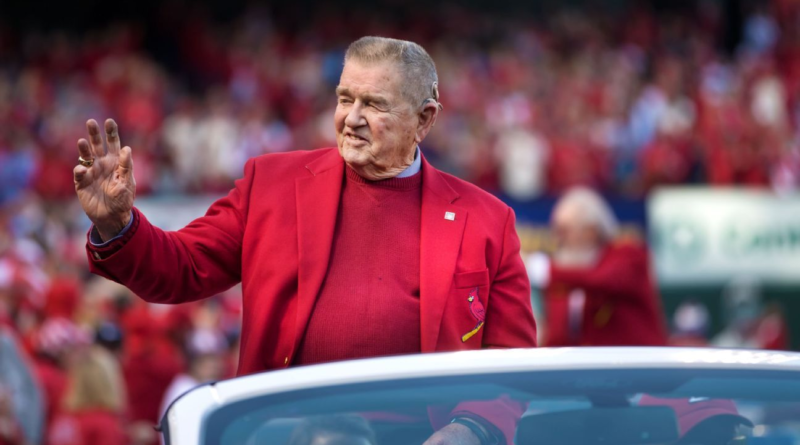HOF skipper Herzog, known for 'Whiteyball', dies
NEW YORK — Whitey Herzog, the gruff and ingenious Hall of Fame manager who guided the St. Louis Cardinals to three pennants and a World Series title in the 1980s and perfected an intricate, nail-biting strategy known as “Whiteyball,” has died. He was 92.
“Whitey spent his last few days surrounded by his family. We have so appreciated all of the prayers and support from friends who knew he was very ill. Although it is hard for us to say goodbye, his peaceful passing was a blessing for him,” his family said in a statement released by the Cardinals.
Herzog had been at Busch Stadium on April 4 for the Cardinals’ home opener.
A crew-cut, pot-bellied tobacco chewer who had no patience for the “buddy-buddy” school of management, Herzog joined the Cardinals in 1980 and helped end the team’s decade-plus pennant drought by adapting it to the artificial surface and distant fences of Busch Memorial Stadium. A typical Cardinals victory under Herzog was a low-scoring, one-run game, sealed in the final innings by a “bullpen by committee,” relievers who might be replaced after a single pitch, or temporarily shifted to the outfield, then brought back to the mound.
The Cardinals had power hitters in George Hendrick and Jack Clark, but they mostly relied on the speed and resourcefulness of switch-hitters Vince Coleman and Willie McGee, the acrobat fielding of shortstop and future Hall of Famer Ozzie Smith and the effective pitching of starters such as John Tudor and Danny Cox and relievers Todd Worrell, Ken Dayley and Jeff Lahti. For the ’82 champions, Herzog didn’t bother rotating relievers, but simply brought in future Hall of Famer Bruce Sutter to finish the job.
“[The media] seemed to think there was something wrong with the way we played baseball, with speed and defense and line-drive hitters,” Herzog wrote in his memoir “White Rat: A Life in Baseball,” published in 1987. “They called it ‘Whiteyball’ and said it couldn’t last.”
Under Herzog, the Cards won pennants in 1982, 1985 and 1987, and the World Series in 1982, when they edged the Milwaukee Brewers in seven games. Herzog managed the Kansas City Royals to division titles in 1976-78, but they lost each time in the league championship to the New York Yankees.
“On behalf of the entire St. Louis Cardinals organization, I would like to offer our condolences to the family and many friends of Whitey Herzog,” Cardinals chairman and chief executive officer Bill DeWitt Jr. said in a statement. “Whitey and his teams played a big part in changing the direction of the Cardinals franchise in the early 1980s with an exciting style of play that would become known as “Whitey Ball” throughout baseball. Whitey loved the Cardinals, their fans, and St. Louis. He will be sorely missed.”
The entire Cardinals family is heartbroken to learn of the passing of Hall of Famer and World Series champion manager Whitey Herzog at the age of 92. pic.twitter.com/PLwAM6PV4V
— St. Louis Cardinals (@Cardinals) April 16, 2024
Overall, Herzog was a manager for 18 seasons, compiling a record of 1,281-1,125. He was named Manager of the Year in 1985 and voted into the Hall by the Veterans Committee in 2010, his plaque noting his “stern, yet good-natured style,” and his emphasis on speed, pitching and defense. Just before he formally entered the Hall, the Cardinals retired his uniform number, 24.
“On behalf of Major League Baseball, I extend my deepest condolences to Whitey’s family, his friends across the game, and the fans of the Cardinals and the Royals,” commissioner Rob Manfred said in a statement.
When asked about the secrets of managing, he would reply a sense of humor and a good bullpen.
Dorrel Norman Elvert Herzog was born in New Athens, Illinois, a blue-collar community that would shape him long after he left. He excelled in baseball and basketball and was open to skipping the occasional class to take in a Cardinals game. Signed by the New York Yankees, he was a center fielder who discovered that he had competition from a prospect born just weeks before him, Mickey Mantle.
Herzog never played for the Yankees, but he did get to know manager Casey Stengel, another master shuffler of players who became a key influence. The light-haired Herzog was named “The White Rat” because of his resemblance to Yankees pitcher Bob “The White Rat” Kuzava.
As a player, Herzog batted .257 over eight seasons and played several positions. His best year was with the Baltimore Orioles in 1961, when he hit .291. He also played for the Washington Senators, Kansas City Athletics and Detroit Tigers, with whom he ended his playing career, in 1963.
“Baseball has been good to me since I quit trying to play it,” he liked to say.
After working as a scout and coach, Herzog was hired in 1967 by the New York Mets as director of player development, with Tom Seaver and Nolan Ryan among the future stars he helped bring along. The Mets liked him well enough to designate him the successor to Gil Hodges, but when the manager died suddenly in 1972, the job went to Yogi Berra. Herzog instead debuted with the Texas Rangers the following season, finishing just 47-91 before being replaced by Billy Martin. He managed the Angels for a few games in 1974 and joined the Royals the following season, his time with Kansas City peaking in 1977 when the team finished 102-60.
Many players spoke warmly of Herzog, but he didn’t hesitate to rid his teams of those he no longer wanted, dumping such Cardinals stars as outfielder Lonnie Smith and starting pitcher Joaquin Andujar. One trade worked out brilliantly: Before the 1982 season, he exchanged .300 hitting shortstop Garry Templeton, whom Herzog had chastised for not hustling, for the San Diego Padres‘ light-hitting Ozzie Smith, now widely regarded as the best defensive shortstop in history. Another deal was less far successful: Gold Glove first baseman Keith Hernandez, with whom Herzog had feuded, to the Mets in the middle of 1983 for pitchers Neil Allen and Rick Ownbey. Hernandez led New York to the World Series title in 1986, while Allen and Ownbey were soon forgotten.
Herzog was just as tough on himself, resigning in the middle of 1990 because he was “embarrassed” by the team’s 33-47 record. He served as a consultant and general manager for the Los Angeles Angels in the early ’90s and briefly considered managing the Boston Red Sox before the 1997 season.
If the ’82 championship was the highlight of his career, his greatest blow was the ’85 series. The Cardinals were up 3 games to 2 against his former team, the Royals, and in Game 6 led 1-0 going into the bottom of the ninth, with Worrell brought in to finish the job.
Jorge Orta led off and grounded an 0-2 pitch between the mound and first base. In one of the most famous blown calls in baseball history, he was ruled safe by umpire Don Denkinger, even though replays showed first baseman Jack Clark’s toss to Worrell was in time. The Cardinals never recovered. Kansas City rallied for two runs to tie the series and crushed the Cards 11-0 in Game 7.
“No, I’m not bitter at Denkinger,” Herzog told the AP years later. “He’s a good guy, he knows he made a mistake, and he’s a human being. It happened at an inopportune time, but I do think they ought to have instant replay in the playoffs and World Series.”
As if testing Herzog’s humor, the Hall inducted him alongside an umpire, Doug Harvey.
“I don’t know why he should get in,” Herzog joked at the time. “Doug kicked me out of more games than any other umpire.”
Herzog is survived by Mary Lou Herzog, his wife of 71 years, children Debra, David and Jim and their spouses, nine grandchildren and 10 great-grandchildren.
The Associated Press contributed to this report.




